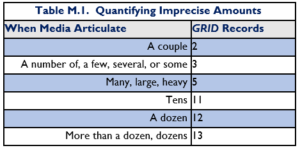The Global Terrorism Trends and Analysis Center (GTTAC) Record of Incident Database (GRID) uses open-source information to record terrorist incidents in the United States and other locations around the world.
About the Annex of Statistical Information on Terrorism
Title 22, Section 2656f, of the United States Code requires the Department of State to present in its annual report on terrorism “to the extent practicable, complete statistical information on the number of individuals, including United States citizens and dual nationals, killed, wounded, or kidnapped by each terrorist group during the preceding calendar year.”
From 2004 through 2011, the information was collected by the National Counterterrorism Center, part of the Office of the Director of National Intelligence, through the Worldwide Incidents Tracking System.
In June 2012 the Department of State contracted with the National Consortium for the Study of Terrorism and Responses to Terrorism (START) to continue this work and present the data in a report titled Annex of Statistical Information on Terrorism that would supplement the Department of State’s annual Country Reports on Terrorism. Using its Global Terrorism Database, START produced the Annex from 2012 through 2017.
In August 2018 the Department of State awarded the contract to Development Services Group, Inc. (DSG), an international research firm with headquarters in Bethesda, Md., and its subcontractor, the Terrorism, Transnational Crime and Corruption Center (TraCCC) at George Mason University. We are responsible for
- Operating the Global Terrorism Trends and Analysis Center (GTTAC) and GRID,
- Producing the Annex of Statistical Information, and
- Editing the Country Reports on Terrorism.
About GRID
GTTAC created GRID to collect and summarize the data on terrorist incidents needed for the Annex of Statistical Information on Terrorism. GTTAC analyzes comprehensive, open-source intelligence gathered through multimedia data aggregators to identify reports of potential terrorist incidents. Data acquisition begins with the use of open-source technology tools developed in Python atop a Linux platform for text analysis, predictive modeling, and feature extraction. GTTAC applies ontologies for terrorist incidents, perpetrators, tactics for attack, weapon use, and the targeting of victims and facilities. After the automated processes have established a body of data for human review and validation, GTTAC aggregates the data based on region and other geographic characteristics. The GTTAC team then reviews the information and enters it in GRID.
GRID is dynamic: It is updated every Sunday with the incident reports GTTAC validated that week. The availability in GRID of contemporaneous incident reports (i.e., reports published by open-source media within the last 3 to 6 months) is contingent on GTTAC research staff being allocated within that timeframe to cover the different geographic areas where the incidents occurred. A calendar year of data is considered “finalized” by the end of the first quarter of the following year (i.e., data entered in GRID throughout calendar year 2022 will be considered finalized on April 30, 2023). However, data about incidents entered in previous years are updated as necessary when GTTAC obtains corrections or additional information published by open-source media concerning those incidents.
How Terrorist Incident Is Defined in GRID
The definition of terrorist incident that GRID uses is approved by the Department of State; conforms with Title 22, Section 2656f, of the U.S. Code; and incorporates elements from the Departments of State and Defense, the Federal Bureau of Investigation, the Central Intelligence Agency, and the UN. As defined in GRID, a terrorist incident is a violent act carried out by non-state actors and individuals (lone actors) that meets the following criteria:
- The violent act aims to attain a political, economic, religious, or social goal.
- The violent act includes evidence of an intention to coerce, intimidate, or convey some other message to an audience (or audiences) larger than the immediate victims.
- The violent act occurred outside the precepts of international humanitarian law in that it targeted non-combatants.
GRID only includes incidents that meet all three criteria. If terrorists initiate an action that targets military or police forces, GRID considers these non-civilian targets as non-combatants and classifies the action as a terrorist incident. Example: Terrorists plant an improvised explosive device or carry out another type of ambush attack on a military patrol. However, a coordinated counterterrorism operation in which military forces initiate an attack against terrorists is not classified as a terrorist incident.
Other Considerations
A rigorous approach to data collection when the information is open source must include strategies for addressing two major challenges. First, not all media outlets have the same reporting standards. GTTAC strives to keep the data collection process from being biased by unreliable media coverage, especially in conflict zones. To this end, GRID includes only terrorist incidents that are reported by independent and reliable sources. GRID does not use any reports from terrorist media sources, and it excludes any incidents about which there is considerable uncertainty or conflicting reporting.
Second, quantifying harm to victims and identifying the perpetrators of terrorist incidents are challenging when the open-source information (particularly about the number of persons killed or wounded) is imprecise. We address this issue in several ways:
- GTTAC employs a well-trained, multilingual, and multicultural team of subject-matter experts, technologists, and researchers who continually monitor and enhance the methodology and thereby maintain a comprehensive, accurate, and systematic process for collecting data in more than 90 languages.
- GTTAC has established an international advisory board, the Global Terrorism Experts Group, which reviews content and ensures objectivity by capturing local contexts and nuances.
- To strengthen data accuracy and completeness while maintaining consistency, GTTAC created a scale (Table M.1) that uses the principle of the lowest reasonable estimate for quantifying imprecise amounts reported in the media:

Before 2018, data on persons killed and wounded were omitted when open-source information did not cite specific numbers; casualties described in terms such as “a few,” “many,” or “dozens” were classified as “missing data” and were not counted. Because GRID counts these casualties in accordance with the scale in Table M.1, its numbers tend to be higher than those reported by START (2012-2017) and the Worldwide Incidents Tracking System (2004-2011).




